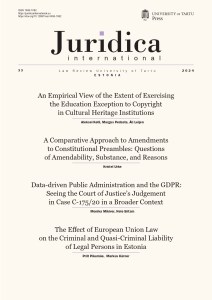Estonian Contribution to the Enlarged European Union
IX/2004
ISBN 9985-870-19-0
Issue
Criminologists have been wondering about the effects of making sentencing policies stricter or more lenient, of using custodial punishments more or less often for decades and decades. Traditionally, the rationales for sentencing an offender to imprisonment include retribution, rehabilitation, deterrence, and incapacitation. Retribution refers to the use of imprisonment as a form of punishment of the offender, a way of ‘doing justice’. It is, strictly speaking, not a crime control strategy. Rehabilitation, on the other hand, aims at controlling crime through the treatment of offenders, while deterrence uses sanctions as a way of inhibiting the criminal activities of the offender (‘special deterrence’) or other potential offenders (‘general deterrence’). Finally, incapacitation uses imprisonment as a way of isolating offenders from the rest of society so that they are unable to commit offences during their confinement. *1
The effects of custodial punishments have been examined in a substantial body of empirical research, the best known examples of which are: Clarke (1974) *2 , Greenberg (1975) *3 , Shinnar and Shinnar (1975) *4 , Cohen (1982, 1983) *5 , Bernard and Ritti (1991) *6 , and Marvell and Moody, Jr. (1994). *7 But the research evidence suggests that estimates of the impact of collective incapacitation vary considerably from one study to another and depending on the severity of the policy. However, even a modest reduction in crime involves paying a heavy price in terms of increases in the prison population: a ten per cent decrease in crime typically requires a doubling of the prison population. Selective incapacitation promises a better tradeoff by targeting offenders who have high rates of offending. Such policies, however, punish offenders on the basis of prediction, an exercise heavily criticised on both technical and ethical grounds. The attractions of such policies are considerably diluted in light of the fact that the crime reduction benefits have been found to be much more modest than initially claimed and the rate of ‘false positives’ unacceptably high. *8
Despite the already ample research on the topic, the ever-broadening use of imprisonment in the United States (see Chart 1) brings the issue to the forefront again and again. In Estonia, the issue has become especially attractive because of discussions about a trend in sentencing policies toward harsher punishments. *9
Chart 1. Number of persons in custody in the USA. *10

Concurrently with the increase in the number of persons in custody, the rate of property crime victimisation has been decreasing, and since the early 1990s, the rate of violent crime victimisation and the number of recorded violent and property crimes have been decreasing as well. *11 Of course, the correlation between the increasing imprisonment and decreasing crime rate in the USA has been used to advance the idea that increasing the severity of custodial punishment can be an effective crime prevention measure.
As we can see from Table 1, a decrease in crime rate is not as rare a phenomenon as could be expected from the daily news, which is more and more often full of reports about crimes. Table 1 shows that crime victimisation surveys have revealed that at the end of the 1990s, decreasing criminal victimisation rates were characteristic not only in the USA but for many other countries as well, among them Australia, Canada, Finland, France, the Netherlands, and Switzerland. The list of countries includes several countries with a prison population that is not increasing or is even decreasing (see Table 2).
In spite of the fact that there have been several arguments put forth to demonstrate that this concurrence of trends does not prove any causal relation between them, the idea that increasing the severity of custodial punishment can be an effective means of crime prevention has found new adherents in many countries, including Estonia.
Now let us take a look at the situation in Estonia to find out whether we can find in Estonia peculiarities that could suggest that increasing the severity of custodial punishment in Estonia could be more effective in crime prevention than the experience of other countries has been suggesting. We should try to analyse how repressive today’s Estonian sentencing policy and practice are, and to figure out whether a further increase in repressiveness could have a great enough positive effect to overcome the negative consequences of the increase.
As of the end of 2003, there were 4352 persons in custody in Estonia, among them 219 women and 146 younger than 18 years old. Of these, 70.5% were serving their sentences and 29.5% were in pre-trial custody. *12 There are 340 prisoners per 100,000 inhabitants — the figure is six times higher than the corresponding figure for the Nordic countries.
Table 1. Trends in crime according to the data from four international criminal victimisation surveys: number of crimes experienced per 100 people in the sample. *13
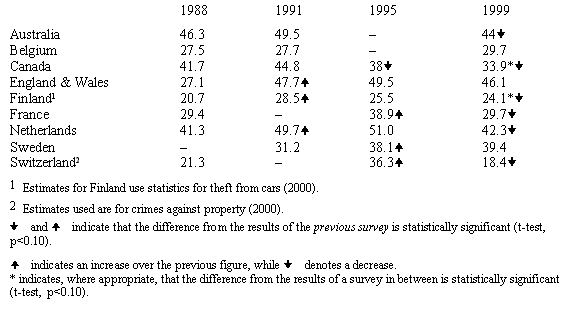
Table 2. Total number incarcerated, rates per 100,000 population. *14
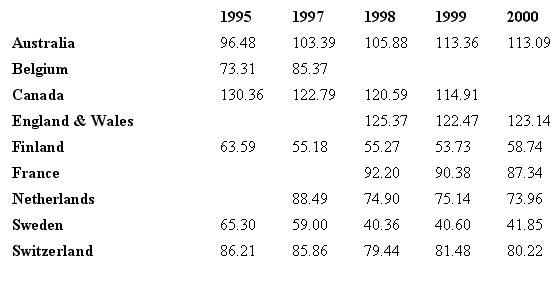
The dominant public opinion in Estonia is that sentencing has become too lenient to criminals over the course of the 90s. This opinion goes along with the belief that by making the sentencing policy harsher it is possible to achieve a significant decrease in criminal behaviour. As an example of these attitudes, the latest indicators of public opinion demonstrate that up to 85 per cent of the Estonian population support the idea that Estonia should reintroduce the death penalty. *15 These results cannot be taken as statistically relevant, because the sample was not random (it consisted of those who called in to a television discussion programme), but it still indicates that hope in harsher sentences as an effective tool for crime prevention is very high.
Becoming tougher on criminals is part of Estonia’s official government policy today; the coalition agreement between the parties who support the incumbent government has a separate chapter on ‘[e]fficient penal policy corresponding to the public perception of justice’, the main ideas are:
– stricter punishments for drug crimes (drug dealing), as well as for grave offences against the person: up to life imprisonment;
– stricter punishments for organised crime and imposition of criminal liability on the organiser of crime for the activities of the entire criminal organisation;
– inclusion of an attack against persons performing legal protection duties (policemen, investigators, judges, and prosecutors) among aggravated forms of crime;
– stricter punishments for offences that substantially disturb public (illegal forest-cutting, desecration of objects of heritage conservation, sale of alcohol to minors, grave offences against public order, graffiti,etc.);
– a stricter penal policy that corresponds to public expectations in respect of drug dealing, crimes against the person, and recurrent grave offences;
– introduction of a penal practice according to which a short but effective punishment — i.e., short-term imprisonment, detention, or community service — is imposed on first-time offenders; etc. *16
The high attractiveness of stricter punishments among different segments of the Estonian population seems to indicate a high inertia in these attitudes, because, as indicated by Chart 2, the crime rate, which was increasing sharply in the 1990s, has been stable and even decreased since the year 2000. Therefore, it is not possible to assert that the felt need for stricter punishments arises from an increasing crime rate.
Chart 2. Number of recorded crimes in Estonia. *17

Table 3 shows us changes occurring in recent years in a commonplace indicator of the repressiveness of sentencing — namely, the number of persons in custody. As we can see, the changes have been insignificant and no clear trend of change has emerged. There is still one clear and indisputably positive tendency: the percentage of prisoners who are in pre-trial detention has dropped (from 40% in 1995 to less than 30% in 2002), and, at the same time, the percentage of prisoners who have already been convicted increased from 60% in 1995 to more than 60% in 2002.
The other statistical indicators do not give unanimous support to the idea of overly lenient sentencing either. Very much depends on which indicators to accord more authority. Supporters of the idea that sentences have became too lenient stress the importance of the proportion of persons sentenced to unconditional imprisonment among all convicted persons. And this indicator really gives a hint that the percentage of convicted persons who have been sentenced to imprisonment has been on the decrease (see Chart 3).
Compared to the proportion of unconditional imprisonment in the early 1990s (nearly 30%), the ratio has become much closer to 20 per cent. The decrease took place mostly in the early 1990s. For the years since 1993, it is impossible to confirm any clear tendency.
But the chart does not give the real picture of usage of custodial sentences. The chart does not include detention (short-term custodial sentences: before September 2002, up to three months and since
Table 3. Number of persons in Estonian prisons. *18
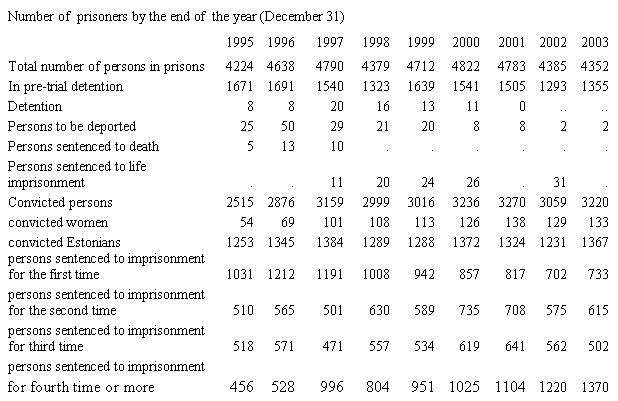
* In 2001, Ministry of Justice statistics included the persons serving the life sentence in the total number of persons serving prison sentence
Chart 3. The percentage (the first scale) and absolute figure (the second scale)
of persons sentenced to unconditional imprisonment. *19

Table 4. Percentages of different sentences types *20

If we sum the imprisonment and detention figures, it will be clear that the changes in the ratio of custodial sentences to all sentences are statistically insignificant (see Chart 4). There was a certain amount of decline until 1994, when the proportion was only 25.2 per cent, but by 2001 it had increased and already become over 30 per cent.
Chart 4. Custodial sentences (imprisonment + detention) as a proportion of sentences *21
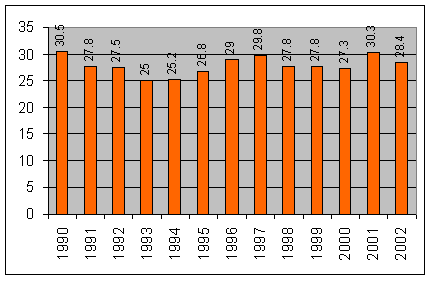
A very different impression can be gained if we measure repressiveness in terms of the total number of persons sentenced to unconditional imprisonment. This figure has increased by nearly three times (see Chart 3); if one takes into account detention as well, the increase is more than threefold (from 1079 cases in 1990 to 2853 imprisoned persons in 2001, with an additional 568 persons sentenced to detention).
Undoubtedly, the sharp increase in the number of persons given custodial sentences disproves the assertion that it is self-evident that sentencing has become more lenient.
Here we should still not forget that the average prison sentence has become significantly shorter. The trend has quite closely followed the pattern of change of the ratio of unconditional imprisonment to all sentences. In the early 1990s, prison sentences rapidly became shorter and shorter (average term: 3.5 years in 1991 and only 2.4 as early as in 1993). Later, there was correction in a rebound toward longer sentences, and the most recent years have been characterised by a return to shorter sentences (2.1 years on average in 2002).
Looking at less repressive punishments reveals that significant changes occurred here as well in the early 1990s. The proportion of various kinds of conditional imprisonment declined from a 1991 high of 58.6 per cent to 44.6 per cent in 1993, and the proportion of fines increased in the same period, from 13.2 per cent to 30.0 per cent. After 1993, the proportions of these sentences have been reasonably stable. Only a slight decrease in the number of fines could be observed over the last few years (see Chart 5).
Chart 5. Percentage of conditional imprisonment and fines. *22

The ratio of unconditional imprisonment sentences varies significantly between different courts, from 0 in some courts in some years to 62 per cent in Järva County Court in 2002.
High volatility has characterised the sentencing practices of several courts; e.g., in Võru County Court, 43.6 per cent of convicted persons were sentenced to unconditional imprisonment in 1996, but only 9.4 per cent in 2000, and the same figure for Rapla County Court was 10.6 per cent in 1995, then 31.6 in 1997 and back to 10.7 per cent in 2000. *23
Generally, the Estonian trial courts can be divided into three clusters according to their sentencing practices. The first cluster consists of courts in the industrial region of North-Eastern Estonia (Ida-Viru County Court, Narva City Court, and Kohtla?Järve and Sillamäe City Courts, the latter two have now merged with the Ida-Viru County Court) *24 and of Harju County Court (a comparatively industrial county including the Estonian capital, Tallinn *25 ). The courts in this group have the strictest sentencing policy: 30–40 per cent of all convicted persons are sentenced to unconditional imprisonment in these courts. The second cluster consists of the city courts, in particular Tartu and Pärnu City Court (now merged with the respective county courts), Tallinn City Court and
If we look at the dynamics of unconditional and conditional imprisonment sentences (see Chart 6), we can see that both types were decreasing significantly in the early 1990s (as mentioned earlier, the decrease was mostly explained by the increasing use of fines). But looking at unconditional prison sentences as a percentage of prison sentences (see Chart 7), anybody should be able to notice that the figure has been very stable. This percentage evidences one of the most stable characteristics of sentencing practice (fluctuating between 32.2 and 37.5 per cent).
Chart 6. Unconditional and conditional imprisonment as a percentage of sentences. *26

Chart 7. Unconditional imprisonment as a percentage of prison sentences. *27

Detention has become a more and more common sentence; it was constantly increasing by percentage until 2001. But as 2002 saw the proportion of detention sentences to have actually decreased slightly, it may be expected that use of detention has already reached its peak and further significant increases should not be assumed.
The length of the average unconditional imprisonment sentence has shown a clear trend of becoming shorter and shorter. Especially noticeable is the increase of the absolute figure for unconditional imprisonment of less than one year: this figure has increased more than tenfold since 1991 (see Chart 8). Speaking in rough terms, one may assert that the increase in the number of unconditional prison sentences has occurred predominantly due to an increase in the total number sentenced to unconditional imprisonment for a term of less than one year.
Chart 8. Absolute figures for unconditional imprisonment for different terms. *28

From Chart 9, we can see that the same tendency (a sharp increase in unconditional prison sentences for a term of less than one year) emerges if one conducts a comparative analysis of the dynamics of the percentages describing the use of unconditional prison sentences for different terms. Prison sentences for a term of less than one year have became the most frequently used form of unconditional imprisonment and have already exceeded the share of the previously dominant term, imprisonment for one to two years — in recent years, close to 40 per cent of all unconditional prison sentences have been for under a year. Large?scale use of short prison sentences is commonplace in many European countries, but it requires that the prisons in which short sentences are served be mostly free of elements of a strong criminal subculture. In Estonia, short prison sentences are served in new prisons but also in prisons with a long history of a strong criminal subculture. Therefore, the use of short prison sentences in Estonia merits further research, to establish whether short prison sentences should not be used so often until all the prisons in which short prison terms are to be served are for the most part free of strong elements of a criminal subculture.
Chart 10 clearly illustrates the trend for the average unconditional prison term to become shorter. While in the early 1990s the average unconditional prison term was ca. three years, by 2002 it was already only very slightly over two years. Again, this tendency is mostly explained by the increasing use of unconditional prison terms of under a year.
Chart 9. Percentages of unconditional imprisonment for different terms.

Chart 10. Average length of an unconditional prison sentence, in years.

Conclusions
Research evidence suggests that estimates of the impact of collective incapacitation vary considerably from one study to another and depend on the severity of the policy. However, even a modest reduction in crime involves paying a heavy price in terms of increases in the prison population. Selective incapacitation promises a better tradeoff by targeting offenders who have high rates of offending. Such policies, however, punish offenders on the basis of prediction and profiling, an exercise heavily criticised on both technical and ethical grounds. The attraction of such policies is considerably diluted by the fact that the crime reduction benefits were found to be much more modest than initially claimed and the rate of ‘false positives’ unacceptably high.
After considering these matters, we took a look at the situation in Estonia to find out whether we can find in Estonia peculiarities that could suggest that increasing the severity of custodial punishment might be a more effective crime prevention measure than the experience of other countries has been suggesting. We also sought to determine whether further increases in repressiveness could have enough positive effects to overcome the negative consequences of such an increase.
It can be asserted that analyses of the dynamics of the sentencing practices of the years 1990–2002 indicate that the absolute figures for the use of unconditional custodial sentences have increased significantly (more than threefold). This tendency is undoubtedly partly grounded in the substantial (more than twofold) increase in the number of recorded crimes. For the most part, the increase in the absolute figures for unconditional prison sentences is accounted for by an increase in the absolute figures for unconditional imprisonment for a term of less than one year. The effects of widespread use of prison terms shorter than one year need further research.
There are significant differences between the sentencing practices of different courts. The reasons for the differences and the soundness of these need further research. The average unconditional prison sentence has become significantly shorter. In part, this can be explained by newly criminalised acts that are punished as a rule by imposition of unconditional prison terms shorter than one year (namely, repeated driving while intoxicated) and by the decreased use of long-term prison sentences.
This tendency brings our sentencing practices closer to the policies of the Nordic countries, in which the average unconditional prison term is still significantly shorter. The attempts to change Estonian sentencing policy in favour of harsher sentences may have some cause where certain crimes are concerned, but the research did not reveal substantiated grounds for a general increase in the repressiveness of sentencing policy.
pp.125-135


